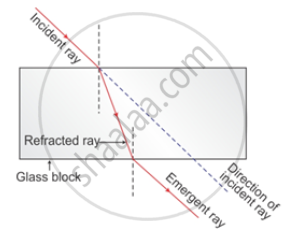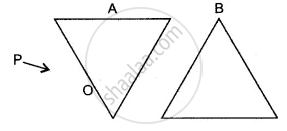Advertisements
Advertisements
Question
Light passes through a rectangular glass slab and through a triangular glass prism. In what way does the direction of the two emergent beams differ and why?
Solution
In case of a rectangular glass slab, emergent rays of light are always parallel to the direction of incident rays.


When a light ray passes through a prism, it bends towards the base of the prism. Hence, incident ray and emergent ray are not parallel to each other as they are in case of a glass slab.
APPEARS IN
RELATED QUESTIONS
Draw a ray diagram to show the refraction of a monochromatic ray through a prism when it suffers minimum deviation
The following diagram shows a 60°, 30°, 90° glass prism of critical angle 42°, Copy the diagram and complete the path of incident ray AB emerging out of the prism marking the angle of incidence on each surface.

(i) What is the relation between the refractive index of water with respect to air `("_aμ_\text(w))` and the refractive index of air with respect to water `("_\text(w)μ_ a)` .
(ii) If the refractive index of water with respect to air `("_aμ_\text(w))` is`5/3`. Calculate the refractive index of air with respect to water `("_\text(w)μ_ a)` .
Define the term refractive index of a medium. What do you understand by the statement 'the refractive index of glass is 1.5 for white light'?
The critical angle for glass-air interface is :
What is meant by the refraction of light?
Express the refractive index μ of a medium in terms of the velocity of light.
The refractive index of air with respect to glass is defined: as gµa = sin i/sin r
Write down a similar expression for aµg in terms of angle i and r.
The figure shows two prisms A and B. A monochromatic ray of light PO is incident at the face of the prism A. Complete the diagram to show the path of the ray till it emerges out of the prism B.

Consider these indices of refraction: glass: 1.52; air: 1.0003; water: 1.333. Based on the refractive indices of three materials, arrange the speed of light through them in decreasing order.
